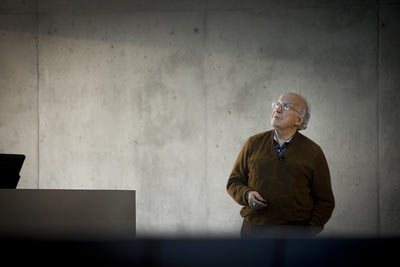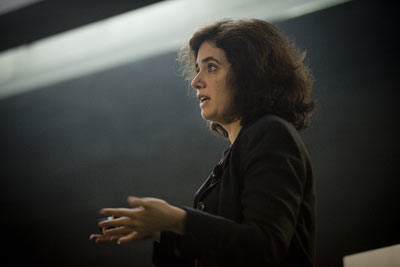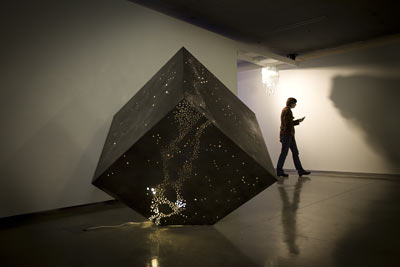Scientists celebrate beauty of light with bubbles, fireflies
By Vivek Venkataraman



Light enables us to perceive color, form and movement and is used by various organisms, including humans, to communicate information, said Cornell scientists gathered as part of LUX -- a light, art and nature exhibition April 21 in Milstein Hall auditorium.
The exhibition drew renowned "light" artists and scientists from around the world to discuss and demonstrate how light inspires them to create and innovate.
Philip Krasicky, senior lecturer in physics, explained that light is a vibration of electric and magnetic fields in empty space and that white light actually consists of a spectrum of colors. Objects acquire color due to absorption and reflection of different parts of the spectrum.
"Plants appear green because of the chlorophyll pigment that reflects green but absorbs the other colors for photosynthesis," he said. "Absorption spectra also act as 'fingerprints' of elements in nature, revealing the structure of atoms."
Krasicky said that color can also result from the interference of light reflecting off microscopic structures, giving soap bubbles, thin oil films and butterfly wings their beautiful iridescence.
Light can be confined, guided, bent and distributed on miniscule dimensions, a thousand times smaller than the width of a human hair, showed Michal Lipson, associate professor of electrical and computer engineering. This field of nanophotonics can revolutionize next-generation computers, resulting in higher speed and lower heat generation, she said.
Using such tiny structures, scientists can even make objects invisible by bending light around them to avoid scattering. "It turns out that Harry Potter's idea of putting a cloak around an object to make it invisible isn't that crazy," Lipson said.
An event can be cloaked, showed Mordechay (Moti) Fridman, a postdoctoral associate in applied physics, by creating a light gap in time. He further showed how different colors of light travel at different speeds through an optical fiber made of glass, and this property can be used to speed up the front part and slow down the back part of a light pulse, Fridman said. This creates a time gap where no light is present to detect any event.
Roald Hoffmann, the Frank H. T. Rhodes Professor of Humane Letters Emeritus and the 1981 Nobel laureate in chemistry, presented the history and chemistry of indigo dyes that are used to color textiles blue. Indigo is a carbon-rich organic compound that reflects the blue part of the spectrum of white light.
"In ancient times, indigo was extracted from sea snails, making them more expensive than gold. You required about 10,000 snails for one gram of the dye," he said. Later, several plant species were identified as producing indigo. Nowadays, indigo dyes are produced by synthetic chemistry mainly to produce denim for blue jeans, a billion pairs of which are manufactured annually.
Cole Gilbert, professor of entomology, showed how fireflies flash light on and off during courtship with colors varying from yellow in the early evening to green in the night. He also showed how predatory maggots living in caves lure their insect prey by attracting them with a bluish glow. Even single-celled marine microbes emit light when perturbed by small fish predators, possibly to attract the big fish "police."
The event was organized by the Departments of Art and of Physics and was funded in part by the Cornell Council for the Arts. The art installations will be exhibited in Milstein Gallery, Willard Straight Hall Gallery and Garden Room until May 11.
Graduate student Vivek Venkataraman is a writer intern at the Cornell Chronicle.
Media Contact
Get Cornell news delivered right to your inbox.
Subscribe